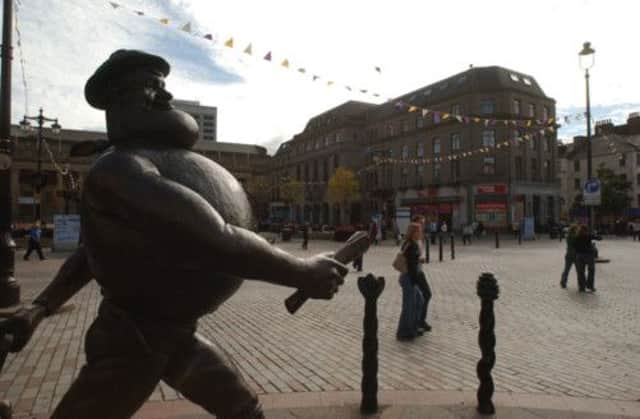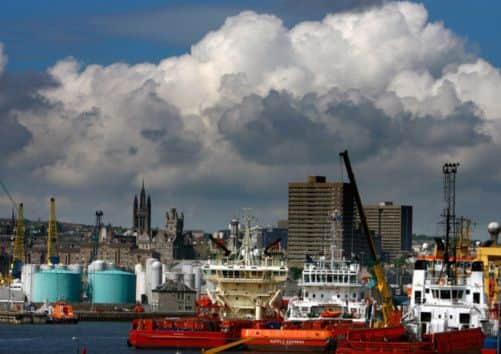Aberdeen and Dundee show off their cultural side


One is the Granite City, home to trawlers, ancient universities and hi-tech oil firms. The other made its name in jute, jam and journalism and its love affair with media has continued in the 21st century as a centre for computer game innovation. Now Aberdeen and Dundee, two cities whose tough reputations have been hewed by demanding industries and the cold winds of the North Sea, are hoping to show off their more refined sides by claiming the title of UK City of Culture 2017.
Today is the deadline for the initial submissions from the 11 cities who have put forward their names – or in the case of the East Kent and Swansea Bay applications, the names of several towns – for the title. The bids will be reviewed by an independent advisory panel, with a shortlist to be announced in June.
Advertisement
Hide AdAnd as Derry-Londonderry, the first claimant of the UK City of Culture title, is discovering in this, the award’s inaugural year, the accolade not only highlights the winner’s past and present cultural activities, more importantly, it attracts considerable investment in new cultural projects, something both Scottish hopefuls recognise as increasingly important to their wider economic and social futures.


Edinburgh, of course, has long dazzled the world with its artistic extravaganzas and impressive heritage and Glasgow’s ebullient character makes it hard to ignore for very long, but the cultural contributions of Scotland’s third and fourth- largest cities are too often overlooked.
Which is why the UK City of Culture title – the year-long accolade to be awarded via the Department for Culture, Media and Sport every four years – could make such a difference to either of them. The initiative, inspired by the success of Liverpool as European City of Culture in 2008, is, organisers say, less about recognising cities with strong cultural reputations already in place, and more aimed at encouraging new creative developments.
As the guidelines point out: “The overall aim of the UK City of Culture programme is to encourage the use of culture and creativity as a catalyst for change, to promote the development of new partnerships and to encourage ambition, innovation and inspiration in cultural and creative activity. Cities and areas that bid for the title will need to spell out their own vision for UK City of Culture and how they will use it in making a step change in their area and creating a lasting legacy.”
Aberdeen and Dundee’s lack of cultural reputes are desperately uundeserved. Legendary Dundonians Oor Wullie and William McGonagall have every right to a seat– or upturned bucket – at Scotland’s table of cultural representatives. But if asked to consider Dundee’s more serious cultural role, would those of us born outside the City of Discovery instantly recall that the port is also the birthplace of one of the nation’s leading living authors, AL Kennedy? Or that the city has provided a home and inspiration to a wide range of creative types from the platinum selling band Snow Patrol, who met in the city as students, right back to Frankenstein author Mary Shelley, who wrote of her time as a teenager in Dundee: “It was beneath the trees of the grounds belonging to our house, or on the bleak sides of the woodless mountains near, that my true compositions of the airy flights of my imagination , were born and fostered.”
And the city has been working hard over recent years to develop its cultural strength. The Dundee Contemporary Arts centre has been flying the flag for the region’s thriving arts scene with groundbreaking programmes since 1999 and the city’s £1 billion Waterfront development will feature a new V&A museum focusing on Scotland’s design heritage.
Advertisement
Hide AdAmong those who live in Dundee, enthusiasm for the area’s cultural renaissance is already running high. Councillor Ken Guild, chair of the Dundee Partnership and leader of Dundee City Council, says: “The reaction to our bid has been absolutely fantastic, there has been a huge level of enthusiasm expressed for Dundee to become City of Culture.
“From the outset, we were keen that this should be a people’s bid, based on the strong partnerships that already exist and to build a cultural legacy for the city.”
Advertisement
Hide AdBut even those behind popular We Dundee website (www.wedundee.com), which invited the public to post comments about why Dundee should be City of Culture, recognise its lack of culture renown, framing their request for support as “What surprises you about city?” One respondent says: “Oozing with creativity, and supportive people, from far and wide. Dundee, as many of its inhabitants, stands overly modest about what a great place it is to cultivate culture, with many exceptional pockets of talent and ambition, the city is a stage set for a fantastic show.”
TV presenter and author Martel Maxwell agree that the city has not promoted its cultural heritage as much as it could, saying: “Our cultural heritage is not as widely known as other cities, [because] we just don’t shout about it as much as we should. But the city is starting to advertise itself.” Those bidding believe if Dundee were to be named City of Culture 2017, there would be no need to be overly modest or keep quiet anymore.
Meanwhile, an hour’s drive up the coast, Andrew Learmonth, spokesman for Aberdeen’s bid, is quick to point out that: “This city has been the birthplace and stomping ground of some incredible artists in the UK. Michael Clark, Annie Lennox, Emeli Sande, David Rintoul, Stuart MacBride and up and comers like Kerry Hudson, Rick Redbeard, Laura Main. We really do punch above [our] weight.
“Aberdeen does not have a cultural profile to match its setting, its history, or its economic prowess. It remains a city that is still too often perceived as distant and remote from the rest of the UK. A city that lacks, many would argue with some justification, a recognised contemporary cultural identity.”
He points out that Price Waterhouse Cooper has said Aberdeen needs to attract 120,000 new employees in the next ten years for the energy industry to survive, while the former Scottish Arts Council reported Aberdeen having a cultural engagement rate of 51 per cent against a Scottish average of 71 per cent. Something needs to change. The gap in the otherwise thriving city’s cultural sector poses more serious problems for the city than Aberdonian opera lovers moaning about having to travel to the Central Belt to hear their favourite aria.
Despite its solid historical cultural background – the content of its academic libraries and the ancient buildings that contain them would alone be the envy of most major cities – bid organisers recognise that Aberdeen lacks “cultural confidence”.
Advertisement
Hide AdLearmonth adds: “Aberdeen is a prosperous city, but for too long we have failed to secure significant business investment in the city’s cultural infrastructure. This UK City of Culture bid provides us with an opportunity to galvanise support to realise a shared vision for Aberdeen. It will enable us to tell our story with renewed vigour. It will enable us to connect the north to the wider world – again. And it will enable us to shape our future.”
Already as part of the bidding process plans have started coming together for Aberdeen to host a Japanese Festival – in recognition of Thomas Blake Glover, the 19th-century-industrialist who is a household name in Japan but little known here in Scotland – along with a comedy festival and electric lighting festival.
Advertisement
Hide AdEven the most dismissive Central Belt culture snob could come up with additions to those few Dundee and Aberdeen cultural achievements mentioned here: the 16th-century art of Scotland’s first eminent portrait painter George Jameson of Aberdeen, perhaps; the ballad heritage shared by traditional singers from both cities; or Grand Theft Auto video game legend Rockstar North, which started life in Dundee – the city’s Abertay University now offers a respected MSc in Computer Games Technology. Neither city lacks culture, what they lack is cultural recognition, confidence and reputation.
Yesterday newspapers reported that the celebrity support of actor Orlando Bloom for the East Kent bid and sportsman Tom Daley for Plymouth’s application had caused the two regions’ online support to soar, with Plymouth receiving 1000 “likes” for its picture on Facebook compared with just one for Aberdeen.
And if the title was being awarded for the bonniest Hollywood champion, the bidder backed by doe-eyed Bloom could probably start printing out its UK City of Culture 2017 posters now.
Thankfully it’s not. And while Dundee’s Brian Cox and Aberdeen’s Billy Connolly are unlikely ever to be cast for their elfin good looks, those less-glamorous but hugely talented performers in many ways embody the two Scottish cities’ unpretentious but prodigious cultural heritages.
There’s nothing like a bit of inter-city rivalry to stir up debate and comic and competitive observations about the others’ perceived failings, but either Scottish city making it onto the shortlist could only be a good thing for the entire nation’s cultural future.
The 2017 candidates
ABERDEEN
POPULATION: 212,125
CULTURAL GEMS: Aberdeen Art Gallery and Aberdeen Maritime Museum
Advertisement
Hide AdCELEBRITY BACKERS: comedian Billy Connolly, author Stuart MacBride, musician Dame Evelyn Glennie
CHESTER
POPULATION: 77,040
CULTURAL GEMS: Numerous festivals including Chester’s Midsummer Watch - one of Britain’s oldest festivals
Advertisement
Hide AdCELEBRITY BACKERS: Culture Minister Ed Vaizey recently described Chester as “a jewel in the crown in the north-west”
DUNDEE
POPULATION: 141,870
CULTURAL GEMS: Dundee Contemporary Arts and the forthcoming V&A museum
CELEBRITY BACKERS: TV presenter Lorraine Kelly, actor Brian Cox, singer Sheena Wellington
EAST KENT
AREA COVERED: Ashford, Canterbury, Dover, Folkestone and Thanet, population approx 352,000
CULTURAL GEMS: Canterbury Museum and Canterbury Cathedral
CELEBRITY BACKERS: Hollyood actor Orlando Bloom, designer Wayne Hemingway
HASTINGS AND BEXHILL ON SEA
AREA COVERED: neighbouring parts of East Sussex, population approx 127,000
Advertisement
Hide AdCULTURAL GEMS: The Jerwood Gallery and the De La Warr Pavilion gallery and auditorium
CELEBRITY BACKERS: Jazz musician Liane Carroll
HULL
POPULATION: 256,100
CULTURAL GEMS: Hull New Theatre and the Museums Quarter
CELEBRITY BACKERS: former Cabinet minister Michael Heseltine
LEICESTER
POPULATION: 330,000
Advertisement
Hide AdCULTURAL GEMS: LCB Depot creative hub and Leicester Print Workshop
CELEBRITY BACKERS: if there is anyone, it must be a closely guarded secret. Richard III, perhaps?
PLYMOUTH
POPULATION: 258,700
CULTURAL GEMS: National Marine Aquarium and the British Fireworks Championships
CELEBRITY BACKERS: Olympic diver-turned-reality-TV host Tom Daley, celebrity chef Gary Rhodes
PORTSMOUTH AND SOUTHAMPTON
POPULATION: 446,800
CULTURAL GEMS: Sea City Museum and Mary Rose Museum
CELEBRITY BACKERS: none yet, joint bid was only agreed last month
SOUTHEND ON SEA
POPULATION: 174,300
CULTURAL GEMS: City Beach and Southend Pier Cultural Centre
CELEBRITY BACKERS: David Amess, the Tory MP who described Southend’s rival candidates as “absolute dumps”
SWANSEA BAY
Advertisement
Hide AdAREA COVERED: Vast - Swansea, Carmarthenshire, Neath, and Port Talbot, population approx 504,000
CULTURAL GEMS: Dylan Thomas Centre and National Show Caves Centre for Wales
CELEBRITY BACKERS: Hollywood actor Michael Sheen